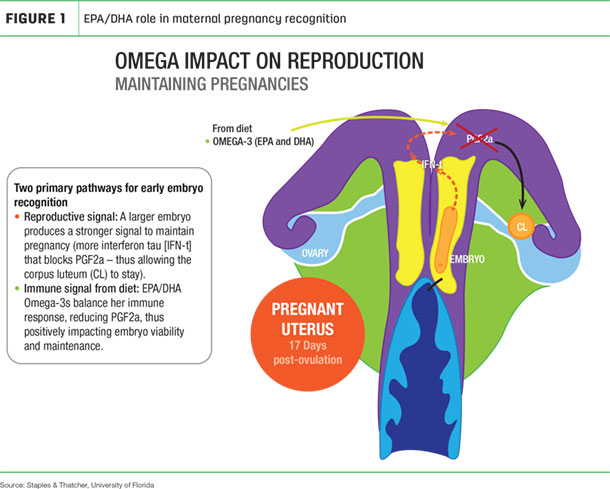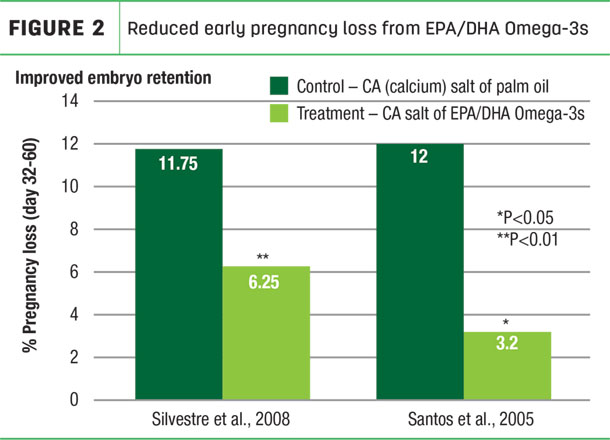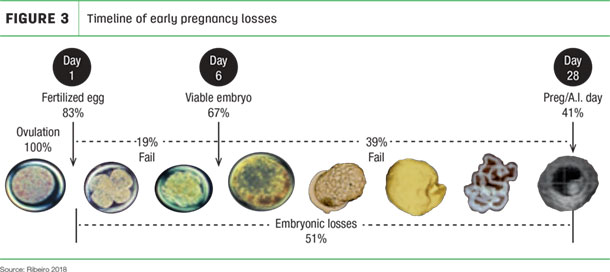In particular, research on feeding omega fatty acids provides great insight into just how critical fatty acids are in achieving high fertility and healthy cows.
In the early 2000s, the groundwork was laid on the impact of omega-3s on reproduction, with most of the improvements stemming from improved embryo retention. More recent research from the University of Guelph is diving deeper into the mechanisms of fatty acids and embryo development, thus helping us learn how to provide the right fatty acids at the right amounts at the right stage of lactation. Let’s first talk about the mechanisms for these improvements and then discuss the results from target feeding omega-3s.
Mechanism for embryo retention
There are two primary pathways for the early recognition of pregnancy: the reproductive signal and the immune signal (Figure 1).

In a pregnant uterus, 17 days post-ovulation, the embryo releases a pregnancy hormone called interferon tau, which reduces the amount of prostaglandin released from the endometrium tissue. This allows the corpus luteum (CL) to stay and maintain pregnancy. In contrast, in a non-pregnant uterus, the prostaglandin causes the CL to regress, and she resumes cycling. The other pathway comes from the immune system, where EPA/DHA omega-3s make their way from the diet to the reproductive tissue of the cow, where they also reduce prostaglandin release from the uterine tissue, creating a better environment for the embryo to be maintained.
Impact on immune regulation
Omega fatty acids also play a role in how cows transition, as these fatty acids are not simply an energy source but are important regulators of immune function. Omega-6s are part of the inflammatory pathway and are the substrates from which prostaglandins are synthesized. Conversely, omega-3s are anti-inflammatory and play an important role in helping resolve inflammation and temper the inflammatory response post-calving.
According to Dr. Eduardo Ribeiro, the effects of excessive body condition loss and clinical diseases in early lactation affect approximately 50 percent of dairy cattle postpartum. Inflammation and fertility are thus inextricably linked. Cows that suffer from transition diseases lose more body condition in early lactation, suffer from unresolved inflammation and have a harder time breeding back. Supplementation of anti-inflammatory omega-3s post-calving and through the breeding period can help resolve inflammation and allow the cow to repartition energy from the inflammation to more productive uses, such as milk production and reproduction.
Research findings
Now let’s take a look at the research progression on feeding EPA/DHA omega-3s to improve fertility.
- Research showed feeding an anti-inflammatory diet with EPA/DHA omega-3s reduced spikes of prostaglandin, creating a better uterine environment to maintain pregnancy.
- Multiple studies showed feeding calcium salts of EPA/DHA omega-3s reduced pregnancy losses between days 32 and 60 of pregnancy by 50 percent or more (Figure 2).

- Most recently, the challenge of early embryo loss in dairy cattle has been reaffirmed with over 50 percent loss by the fourth week of pregnancy due to poor uterine environment or impaired embryo development (Figure 3).

- The latest research from the University of Guelph shows supplying omega fatty acids is critical in the process of elongation of the conceptus, the stage of embryo development in which 39 percent of the losses are occurring (Figure 3). The conceptus uses these fatty acids for energy, cell signaling and mass accumulation as it grows into a sustainable embryo.
Practical next steps
The fatty acids we feed in our dairy rations have a substantial impact on managing inflammation and improving the reproductive outcomes in dairy cows. Fatty acids are not just about providing enough energy for the cow. Sure, that is the most obvious contribution fatty acids make to helping cows perform their best, but that is just the tip of the iceberg into all the mechanisms of fatty acids. With that in mind, here are some possible next steps to better managing transition and reproduction with omega fatty acids.
- Assess the current levels of omega-6 and omega-3s in your transition diets. This can be done by looking at the ratio of omega-6 to omega-3 at the duodenum in ration software or by sending in a TMR sample for fatty acid profile analysis.
- As a guideline, with omega-6-to-omega-3 ratios, lower is better. While there is no magic number, most of the research showing improvements in reproductive performance reached omega-6-to-omega-3 ratios that were 5-to-1 or less at the small intestine.
- Consider ways to improve the omega-6-to-omega-3 ratio, in particular in early lactation when cows deal with the most significant challenges with inflammation. Strategies can include supplementing with calcium (CA) salts that include EPA/DHA omega-3s, as well as ways to reduce inflammatory omega-6s.
- On a side note, omega-6s are also called 18:2 or linoleic acid – it is the same fatty acid that, when fed in excess, can have negative effects on milkfat synthesis. Therefore, this gives you one more reason why monitoring omega-6 levels should be an important part of your nutrition plan.


-
Renee Smith
- Western Sales Manager
- Virtus Nutrition
- Email Renee Smith








